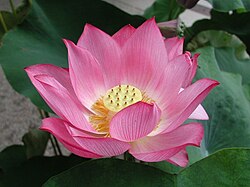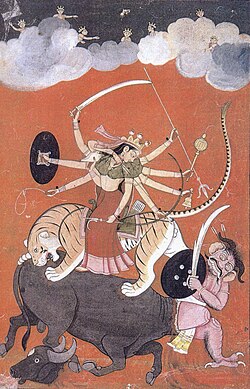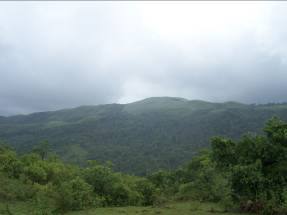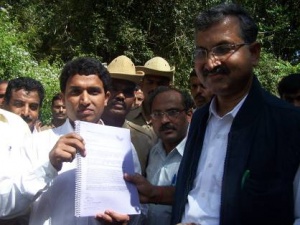Introduction to the Brahma Database
Contents
What is biodiversity
The official definition of biodiversity, as adapted by UN Convention on Biological Diversity is "the variability among living organisms from all sources, including, 'inter alia', terrestrial, marine, and other aquatic ecosystems, and the ecological complexes of which they are part: this includes diversity withinspecies, between species and of ecosystems"[1]
Simply speaking, it is the variation in the life forms in a given ecosystem. More the biodiversity, healthier is the ecosystem.
Introduction to the Brahma Project
Lord Brahma (Sanskrit: ब्रह्मा, IAST:Brahmā) is the Hindu God of Creation. According to Hindu mythology, Brahma is the creator of the entire universe and all life that inhabits it. Our planet is teeming with life, from the abysses of the oceans to hot sandy deserts. The aim of Project Brahma is to create awareness about this diversity of life, with a special focus on the biodiversity of India through various online and grassroots level initiatives.
Project Brahma is the umbrella project consisting of four media:
- This Biodiversity of India wiki
- The Project Brahma blog
- Our Project Brahma Facebook page and
- Our @brahmaproject Twitter account
This website specifically aims to create a robust knowledgebase for all kinds of information about Indian biodiversity.
Documenting India's biodiversity is a challenging task. India has some of the biggest diverse regions in the world. Given the rapid rate of population expansion, habitat fragmentation and species loss in the Indian subcontinent, it has become extremely important to document this biodiversity for the purpose of its conservation.
Efforts to document and conserve biodiversity assume special significance in the Indian context. The flora and fauna of the land are very intricately linked to its culture, its folk medicine and its way of life. For example, elephants may just be "magnificent animals under threat of extinction" in most parts of the world, but in India, they are also majestic symbols of royalty and are deeply engrained in religious and mythic lore. Basil may be a plant used just for cooking in most parts of the world, but in India it is considered holy and worshipped every year during Diwali. The enormous magnitude of biodiversity in India has spawned an equally magnanimous diversity in the customs, religious lore and folk medicinal practices associated with it. Thus, biodiversity documentation and conservation in India is not just of interest to environmentalists and academics, but also to every person interested in documenting and conserving the culture of the country.
Biodiversity of India (BOI) aims to provide a platform to document Indian biodiversity from all of the above mentioned perspectives, and more. The BOI Database will pull in various pieces of scientific information, such as details of binomial classification, morphology, habitat, geographical distribution, genomic data and couple it with the traditional information, such as vernacular names, folk medicinal knowledge and mythic folklore for every species in India. The result will be resource huge in its scope and implications.
However, documentation of biodiversity is not the final aim of this project. The goal of BOI is to act as a platform for encouraging conservation. Through the website and using modern "Web 2.0" technologies such as Twitter, Facebook, Youtube and so on, we plan to spread awareness and education about India's biodiversity. Through Brahma Notes, we aim to highlight the intricate associations between Indian biodiversity and local cultural practices & mythology. One of the important components of the BOI website is the Education division, where we aim to create and compile tools such as online learning modules, blog articles, news, educational videos and biodiversity-related quizzes. In addition, under the umbrella of Project Brahma, we plan to organize grassroots level activities which will feed into the BOI website.
The aforementioned tasks are no doubt enormously challenging. But we have to start somewhere. This is where we start. The Brahma Project will harness the power of community participation to achieve this challenging task. We envision that enthusiasts from all walks of life will join hands through the BOI website to rapidly advance the status of biodiversity documentation and conservation in India. The BOI website will not only serve as an excellent reference for further research, but also make the scientific and traditional knowledge of India's biodiversity accessible all around the world to the common man.
Biodiversity of India
India is a country rich in biological diversity. It lies within the Indomalaya ecozone and houses two of the 34 biodiversity hotspot in the world[2].
There is a huge species diversity in India, with several of the species being endemic to the their native ranges in India[citation needed].
| Group |
Number |
% of world species |
| Mammals |
350 |
7.6% |
| Birds |
1224 |
12.6% |
| Amphibians |
197 |
4.4% |
| Reptiles |
408 |
6.2% |
| Fishes |
2546 |
11.7% |
| Flowering plants |
15000 |
6% |
Sources: Indira Gandhi Conservation Monitoring Centre (IGCMC), New Delhi [3] and IISc [4]
These species have not only contributed to the environmental wellness of India but also its cultural diversity. Arguably, the nation is the most demographically diverse in the world. Only the continent ofAfrica exceeds the linguistic, genetic and cultural diversity of the nation of India.[5]. The country houses 1.6 billion people speaking 1652 languages and dialects[6], spread out over more than two thousand ethnicities and over every major religion. This vast cultural diversity, coupled with the polytheistic tenets ofHinduism, has created an intricate relationship between the culture and biodiversity of India. Plants such as the Indian Banyan and Holy Basil are considered sacred. So are animals like the cow,elephant and the lion.
The biodiversity, especially that in the plant species, has also been used in traditional medicinal systems such as Ayurveda & Unani and in local folk-healing practices. Many of these practices do not exist in written word and those that are documented are not readily accessible. More critically, the knowledge of these practices and the associated knowledge of local biodiversity is being lost at an alarming rate in all parts of India[citation needed]. The Brahma Project aims to contain this trend through the collaborative power of the world wide web. By putting the power to document and characterize India's biodiversity in the hands of anyone with a computer and an internet access.
Overall mission of the Brahma Project
The final objective of Project Brahma is to promote biodiversity conservation through increasing community participation in the activity. Currently, the four major hurdles to community participation are:
1.Lack of awareness about woes facing India's biodiversity: It can be assumed that many Indians know about environmental degradation. For people in cities, it is the excessive pollution and water woes that sensitize them to environmentalism, while in the rural areas, it is the irregularity of monsoons, reducing crop yields, reduction in groundwater and a host of such issues. However, relatively few people are aware of the alarming reductions in the flora and fauna.
2. Lack of awareness about what is at stake: People do understand that messing up with earth's weather will have disastrous consequences on a lot of things. However, what about biodiversity loss? Indian biodiversity is of a unique kind in this world. It has intricate links with our socio-cultural practices and medicinal knowledge. However, these links are rarely appreciated. Loss of biodiversity not only leads to extinction of a given species, but also extinction of the cultural practices and local knowledge associated with that species. For example, tiger is the national animal of India. Tiger is also considered the vehicle of Goddess Durga. They have been depicted as symbols of majesty in Indian culture. However, a resource that makes such knowledge accessible to the common man as well as integrates traditional knowledge with modern scientific inquiry does not currently exist. If such links are depicted clearly, the significance of biodiversity conservation will become more evident to the common man.
3. Inaccessibility of resources for getting that knowledge: Lack of awareness about biodiversity loss can be assumed to be highest among the urban population; people in villages tend to observe the diminishing populations of plants and animals right in front of their eyes (But now-a-days, people living in villages are moving towards small towns and cities. So, most of our traditional knowledge, which is passed down orally, is being rapidly lost...). This lack of awareness in the urban populace is primarily due to having not enough exposure to nature. Additionally, people cannot readily access information about local biodiversity. Most of such information is contained in books, journals or on websites aimed towards the research community.
4. Unavailability of tools that foster community participation in conservation: The first thing that needs to be done for increasing community participation is to get more and more people interested in biodiversity. Raw data, textual information would be of limited use in achieving this. Thus, resources aimed at the common man, to get him more involved in biodiversity conservation are the need of the hour.
Project Brahma provides a unique perspective in tackling these hurdles.
1. Making biodiversity accessible: Although several biodiversity-related resources exist for Indian biodiversity [7], most Indians find these resources rather inaccessible (eg:books in libraries). Additionally, many such resources are limited access i.e. created, curated and managed by experts. Although expert curation substantially increases the quality of data, the common man is shut out of the process of knowledge creation and documentation. Through Project Brahma, we aim to make the process of entering and extracting information related to India's biodiversity easy and accessible to everyone with an Internet connection.
2. Making biodiversity interesting: As mentioned above, the first step for increasing community participation in biodiversity conservation is to make biodiversity interesting and approachable. We live in an Internet age, where technologies such as Youtube, Flickr, RSS and Atom feeds, Google Maps, Twitter etc. provide us with a unique opportunity to make people more interested in knowing more about India's flora and fauna. Project Brahma aims to make full use of these and other available technologies as a means to get more people involved in biodiversity conservation.
3. Education and awareness: If we are to pique people's interest in biodiversity, it is important to do it the right way. Means such as video compilations, quizzes, online learning modules are excellent ways to create rich learning resources. Using expert-knowledge, we plan to create a repository of online learning modules related to India's environment and biodiversity
4. Increasing community participation: The final goal of Project Brahma is to get more and more people involved in biodiversity conservation. Through biodiversity documentation, creation of online learning resources, social networking and Web 2.0 technologies we hope to achieve part of this aim. These approaches would also be supplemented with grassroots level activities, in collaboration with NGOs, schools and colleges, which feed information into Project Brahma. We hope that such a multifaceted approach will provide a significant boost to community participation in biodiversity conservation.
Specific mission of the Brahma Project
The specific goals of this project are as follows:
|
1) To enable "good-quality", "social", "interactive", "hyper-linked" and "referenced" documentation of the flora and fauna of India 2) To integrate traditional and modern knowledge about the biodiversity in India 3) To generate awareness among the common man about the sociocultural, medicinal and economic impact of species loss, and involve them in the activity of biodiversity conservation 4) To provide resources for further education, research and conservation efforts into this area |
Structure
(section under development)
Species Pages
The Biodiversity of India Database is a powerful way of extracting rich information about India's biodiversity. The database uses an intelligent software called Semantic Mediawiki to automatically generate "knowledge" from user-fed information. The more information this database gets as input, the more useful it becomes in terms of knowledge-discovery - almost like an intelligent living organism.
The BOI database runs on two entities - Species pages and Query pages. The species pages are populated by regular human users by filling in a form and making some text entries. This information then becomes part of the database and can be aggregated on query pages, using something called Semantic queries. So if you wanted to find out something as simple as - All plants growing in India - or something as complex as - All endemic plants growing in Karnataka used for treatment of Malaria, have religious significance in Islam and have been commercially exploited - you can do it using this database!
This powerful resource builds on the information provided to it by people like you. The more you are involved with this site, the better it will become. We encourage you to contribute to this website in whichever way you can.
Examples of possible usage
Use in biodiversity conservation: Case of the Gundya Power Project
Source: BCRT and other news.
Hongadahalla Gram Panchayat is located in Sakleshpur taluk of Hassan District in Karnataka. The Panchayat consists of 26 villages and is located in the Western Ghats. The region consists of evergreen rainforests, hills, rivers, streams and lakes. This area is the major habitat for elephant, tiger, bear, cheetah, leopard, king cobra, python, and other wildlife. This region is also a hotspot for medicinal plants and home to several traditional healers. Unfortunately, Karnataka Power Corporation Ltd proposed to deforest Hongadahalla surrounding forest area to construct Gundia Hydro Electric Project. The Gundia Hydro Electric Project would have submerged 1041 hectares of forests thus leading to an enormous loss of species in that region[8]. Environmentalists from all over India were severely concerned by the project since it'd have exacerbated an already fragile ecosystem. They rallied behind the environmental cause, but an exhaustive documentation of the biodiversity of the region was found lacking. Putting hard numbers on the number of species being threatened, their medicinal and cultural significance and economic impacts was a necessity in order to put forth a powerful argument against the power project.
This need led to the active deployment of the People's Biodiversity Register (PBR) in that region. The PBR, a project of the esteemed Indian scientist Dr. Madhav Gadgil aimed to document "the knowledge of occurence, practices of propogation, sustainable harvests and conservation, as well as economic uses of biodiversity resources that resides with India's local communities."[9]. Organizations like Biodiversity Conservation and Research Trust actively moved around villages and documented the practices of the people, their knowledge of biodiversity, the economic importance etc. in a very short span. The resulting database gave a rich picture of the species that'd have been lost as a result of the hydro-electric power project and its impact on the local area. The report was submitted to the Ministry of Environment in 2009. Despite these efforts, the Ministry finally gave a clearance to the project in July 2010 [8], but not without imposing severe restrictions. The extent of land proposed to be inundated by the project was reduced from 1041 hectares to 478 hectares. The Karnataka government also agreed to forgo construction of a storage reservoir which would have led to submergence of massive areas of forest under the dam waters [10].
This example shows that knowledge of the biodiversity and its interaction with the natives is very important for biodiversity conservation in the Indian context.
How can the Brahma Database help in situations like these? The Brahma Project aims to use community-based documentation to document eight different aspects of India's biodiversity. It also enables easy retrieval of the fed-in information. Thus, simple queries such as All plant species with medicinal value and commercial importance growing in Karnataka can be constructed to automatically pull out the required information.
For example, a simple code like this:
{{#ask: [[Category:Plants]] [[state::Karnataka]]
| ?Common name
| ?Common Indian names
| ?Medicinal significance
| ?Plant commercial=Commercial significance
| sort=Common Indian names,Medicinal significance,Plant commercial
| limit=3
}}
will produce this output. The more the information in the database, the more plants the query will show.
| Common name | Common Indian names | Medicinal significance | Commercial significance | |
|---|---|---|---|---|
| Sesamum indicum | Sesame | Juljulan,Simsim,Sumsum,Zelzlane (Arabic) ; Tisi (Assamese) ; Til (Bengali) (Urdu) ; Mittho-tel,Tal (Gujrathi) ; Ellu,Tila (Kannada) ; Chitelu, Ellu (Malayalam) ; Bariktil,Ashadital,Til (Marathi), Ellu (Tamil) ; Nuvvulu, Tillu (Telugu) ; | Yes | Yes |
| Murraya exotica | Chinese box, Orange Jasmine | Kamini कामिनी (Hindi);কামিনী কুসুম Kamini kusum (Manipuri); வெங்காரை Vengarai (Tamil);Nagagolungu (Telugu);कुन्ती Kunti (Marathi);Kadu karibevu (Kannada);lMaramulla (Malayalam) | Yes | Yes |
| Madhuca longifolia | Mahua | Mahua (Bengali);
Mahua, Mahudo (Gujarati); Mahua (Hindi); Halippe,Hippe, Ippe, Movaro (Kannada); Illippa, Pooma (Malayalam); Mahua, Mohwa (Marathi); Illupei (Tamil); Ippa (Telugu) | Yes | Yes |
| … further results | ||||
There are over 70 parameters which can be queried in this manner to retrieve any information available about any plant species in India.
Use in conservation: Identifying endangered species
All species in the Brahma database classified as Endangered or Critically Endangered by IUCN
| Ailurus fulgens (Red Panda), Axis porcinus (Hog Deer), Balaenoptera borealis (Sei whale), Balaenoptera musculus (Blue whale), Balaenoptera physalus (Finback whale, Fin whale, Razorback, Common rorqual), Bubalis bubalis (Water buffalo,Wild Asian buffalo,Wild Asiatic buffalo), Capra falconeri (Markhor), Caprolagus hispidus (Hispid Hare, Bristly Rabbit, Assam Rabbit), Cervus elaphus (Kashmir Stag, Hangul, Red Deer), Cervus eldi (Eld's Deer, Thamin, Brow-antlered Deer), Crocidura andamanensis (Andaman shrew), Crocidura jenkinsi (Jenkin's Shrew), Crocidura nicobarica (Nicobar Shrew), Cuon alpinus (Dhole), Elephas maximus (Indian Elephant, Asian Elephant), Moschus chrysogaster (Alpine Musk Deer), Moschus fuscus (Dusky Musk Deer), Orcaella brevirostris (Irrawaddy dolphin), Panthera tigris (Tiger), Pantholops hodgsonii (Tibetan antelope, Chiru), Platanista gangetica (Gangetic river dolphin), Rhinoceros unicornis (Rhinoceros), Sus salvanius (Pigmy Hog), Uncia uncia (Snow Leopard), Viverra civettina (Malabar Civet,Malabar Large-spotted Civet) |
Use in research: Studying medicinal plants
India has had a rich medicinal tradition. Three primary alternative medicinal systems exist in India - Ayurveda, Unani and Folk Medicine. While Ayurveda and Unani systems have been extensively documented in books in recent times, most of the folk medicinal practices are still passed on through oral traditions. Now, although documentation of Ayurveda and Unani systems exist, it is either not readily accessible or it is not properly integrated with the modern knowledge associated with a species. On the other hand, the undocumented folk medicinal practices are rapidly getting lost not just due to environmental degradation, but also due to migration of the new generation to the cities. The oral tradition is fast stopping with this generation.
How can the Brahma Project help here? As shown in the above example, it is easy to extract out the names of medicinal plants of India and what ailments they are known to cure"
| Common name | Common Hindi Name | Medicinal significance | Medicinal system | Ailment type | Ailment | |
|---|---|---|---|---|---|---|
| Withania somnifera | Indian Ginseng, Winter cherry | अश्वगंधा Ashwagandha | Yes | Ayurveda Unani | Infectious diseases Pains and Inflammation Mental disorders Cancer | Anti-inflammatory Antitumor Antistress Antioxidant Immunomodulatory Hemopoetic mild depressant (tranquilizer) |
| Hibiscus rosa-sinensis | Hibiscus, Chinese hibiscus | गुढ़ल Gurhal | Yes | Ayurveda Folk Medicine | Anticonvulsivant Cardioprotective Hypoglycemic effects Antiproliferative effects in tumor | |
| Embelia ribes | Embelia, False Black Pepper, False Pepper | Vayavidnag, Baberang | Yes | Ayurveda Folk Medicine | Infectious diseases | Antihelmintic Tape worm Ring worm |
| … further results | ||||||
As you will realize, more the data fed into the database, the better this list will become.
Use in conservation of traditional knowledge
References
- ^ "Glossary:Biological Diversity as defined by Convention on Biological Diversity". http://www.biodiv.be/glossary_keywords/B/biological_diversity. Retrieved 2010--5-13.
- ^ Hotspots by region
- ^ Indira Gandhi Conservation Monitoring Centre (IGCMC), New Delhi and the United Nations Environmental Program (UNEP), World Conservation Monitoring Center, Cambridge, UK. 2001.
- ^ Biodiversity profile for India.
- ^ India, a Country Study United States Library of Congress, Note on Ethnic groups
- ^ Mother Tongues of India According to the 1961 Census
- ^ Indian websites documenting biodiversity of India
- ^ a b "Sullia: Gundia Project Gets Nod from Environmentalists Committee".
- ^ "People's Biodiversity Register: A record of India's wealth".
- ^ "Govt. okays Gundya project".




